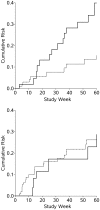Association between unprotected ultraviolet radiation exposure and recurrence of ocular herpes simplex virus
- PMID: 24142918
- PMCID: PMC3873108
- DOI: 10.1093/aje/kwt241
Association between unprotected ultraviolet radiation exposure and recurrence of ocular herpes simplex virus
Abstract
Studies have suggested that exposure to ultraviolet (UV) light may increase risk of herpes simplex virus (HSV) recurrence. Between 1993 and 1997, the Herpetic Eye Disease Study (HEDS) randomized 703 participants with ocular HSV to receipt of acyclovir or placebo for prevention of ocular HSV recurrence. Of these, 308 HEDS participants (48% female and 85% white; median age, 49 years) were included in a nested study of exposures thought to cause recurrence and were followed for up to 15 months. We matched weekly UV index values from the National Oceanic and Atmospheric Administration to each participant's study center and used marginal structural Cox models to account for time-varying psychological stress and contact lens use and selection bias from dropout. There were 44 recurrences of ocular HSV, yielding an incidence of 4.3 events per 1,000 person-weeks. Weighted hazard ratios comparing persons with ≥8 hours of time outdoors to those with less exposure were 0.84 (95% confidence interval (CI): 0.27, 2.63) and 3.10 (95% CI: 1.14, 8.48) for weeks with a UV index of <4 and ≥4, respectively (ratio of hazard ratios = 3.68, 95% CI: 0.43, 31.4). Though results were imprecise, when the UV index was higher (i.e., ≥4), spending 8 or more hours per week outdoors was associated with increased risk of ocular HSV recurrence.
Keywords: UV index; cohort studies; herpes simplex virus; recurrence; sunlight; ultraviolet light.
Figures

Similar articles
-
Psychological stress and other potential triggers for recurrences of herpes simplex virus eye infections. Herpetic Eye Disease Study Group.Arch Ophthalmol. 2000 Dec;118(12):1617-25. doi: 10.1001/archopht.118.12.1617. Arch Ophthalmol. 2000. PMID: 11115255 Clinical Trial.
-
Sunlight is an important causative factor of recurrent herpes simplex.Cutis. 2004 Nov;74(5 Suppl):14-8. Cutis. 2004. PMID: 15603217
-
UV light-induced reactivation of herpes simplex virus type 2 and prevention by acyclovir.J Infect Dis. 1992 Sep;166(3):500-6. doi: 10.1093/infdis/166.3.500. J Infect Dis. 1992. PMID: 1323616 Clinical Trial.
-
A case of recurrent, isolated, simultaneous, bilateral herpes simplex lid infection.J Am Optom Assoc. 1998 Jan;69(1):49-56. J Am Optom Assoc. 1998. PMID: 9479936 Review.
-
UV radiation and mouse models of herpes simplex virus infection.Photochem Photobiol. 1996 Aug;64(2):242-5. doi: 10.1111/j.1751-1097.1996.tb02452.x. Photochem Photobiol. 1996. PMID: 8760562 Review.
Cited by
-
Are there differences in immune responses following delivery of vaccines through acutely or chronically sun-exposed compared with sun-unexposed skin?Immunology. 2020 Feb;159(2):133-141. doi: 10.1111/imm.13128. Epub 2019 Nov 6. Immunology. 2020. PMID: 31593303 Free PMC article. Review.
-
Bilateral viral keratitis following corneal collagen crosslinking for progressive keratoconus.J Ophthalmic Inflamm Infect. 2019 Aug 28;9(1):16. doi: 10.1186/s12348-019-0185-8. J Ophthalmic Inflamm Infect. 2019. PMID: 31463554 Free PMC article.
-
Herpetic Keratitis after Corneal Collagen Cross-Linking with Riboflavin and Ultraviolet-A for Keratoconus.Middle East Afr J Ophthalmol. 2015 Jul-Sep;22(3):389-92. doi: 10.4103/0974-9233.159777. Middle East Afr J Ophthalmol. 2015. PMID: 26180483 Free PMC article.
-
Overweight and Obesity as Risk Factors for Recurrent Herpetic Stromal Keratitis during Long-Term Antiviral Prophylaxis.Viruses. 2022 Dec 16;14(12):2812. doi: 10.3390/v14122812. Viruses. 2022. PMID: 36560816 Free PMC article.
-
Optineurin in ocular herpes infection.Exp Eye Res. 2022 Jun;219:109059. doi: 10.1016/j.exer.2022.109059. Epub 2022 Apr 4. Exp Eye Res. 2022. PMID: 35390332 Free PMC article. Review.
References
-
- Xu F, Schillinger JA, Sternberg MR, et al. Seroprevalence and coinfection with herpes simplex virus type 1 and type 2 in the United States, 1988–1994. J Infect Dis. 2002;185(8):1019–1024. - PubMed
-
- Liesegang TJ, Melton LJ, Daly PJ, et al. Epidemiology of ocular herpes simplex: incidence in Rochester, Minn, 1950 through 1982. Arch Ophthalmol. 1989;107(8):1155–1159. - PubMed
-
- Toma HS, Murina AT, Areaux RG, Jr, et al. Ocular HSV-1 latency, reactivation and recurrent disease. Semin Ophthalmol. 2008;23(4):249–273. - PubMed
-
- Pepose JS, Keadle TL, Morrison LA. Ocular herpes simplex: changing epidemiology, emerging disease patterns, and the potential of vaccine prevention and therapy. Am J Ophthalmol. 2006;141(3):547–557. - PubMed
Publication types
MeSH terms
Grants and funding
LinkOut - more resources
Full Text Sources
Other Literature Sources
Medical

